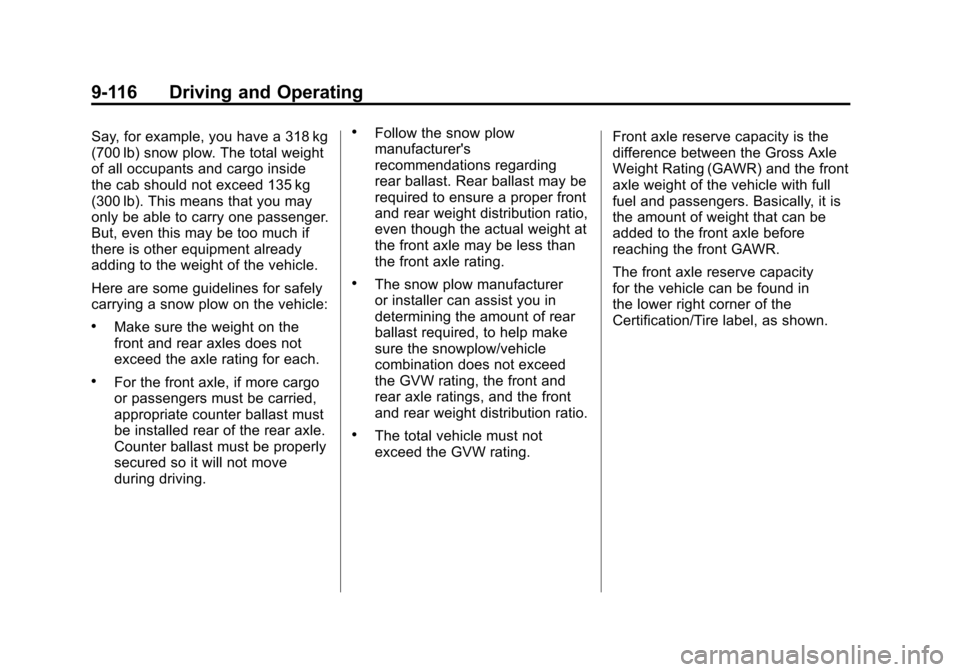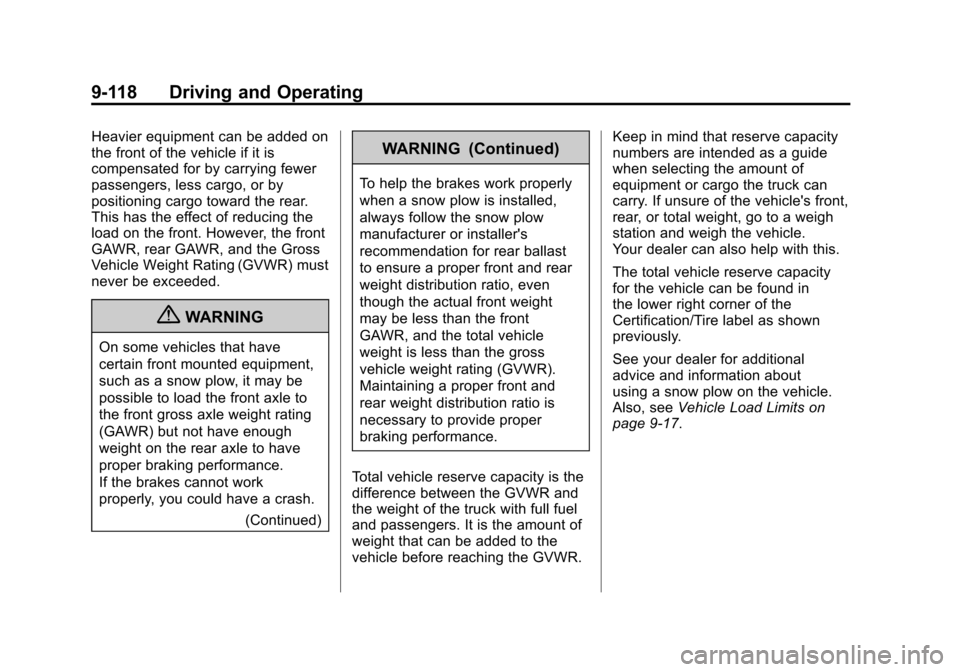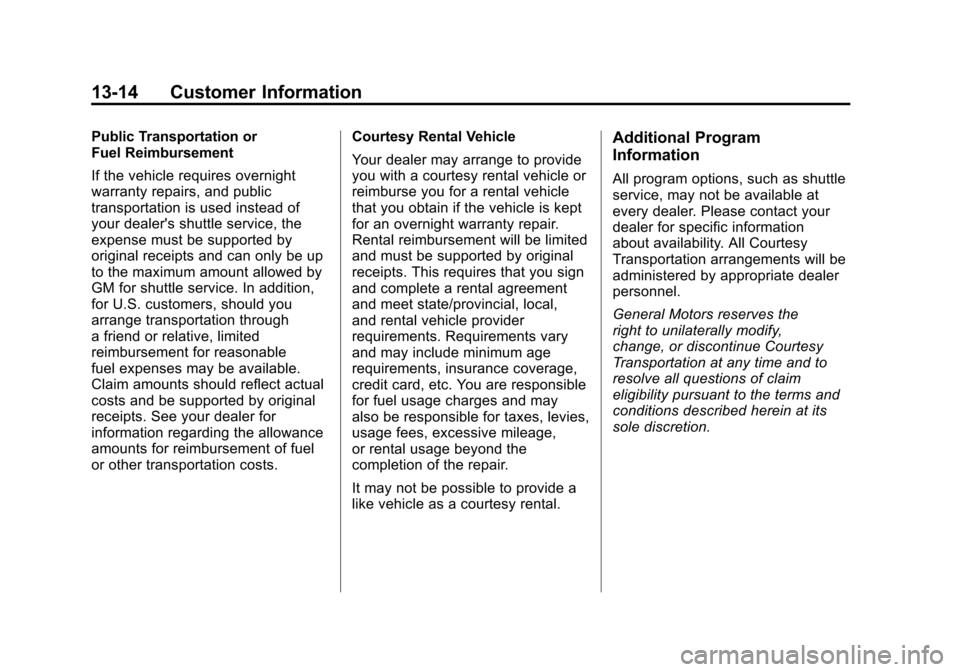2012 CHEVROLET SILVERADO fuel reserve
[x] Cancel search: fuel reservePage 307 of 584

Black plate (21,1)Chevrolet Silverado Owner Manual - 2012
Driving and Operating 9-21
The label shows the size of
your vehicle's original tires and
the inflation pressures needed
to obtain the gross weight
capacity of your vehicle. This is
called Gross Vehicle Weight
Rating (GVWR). The GVWR
includes the weight of the
vehicle, all occupants, fuel, and
cargo.
The Certification/Tire label also
tells you the maximum weights
for the front and rear axles,
called Gross Axle Weight
Rating (GAWR). To find out the
actual loads on your front and
rear axles, you need to go to a
weigh station and weigh your
vehicle. Your dealer can help
you with this. Be sure to spread
out your load equally on both
sides of the centerline.Never exceed the GVWR for
your vehicle, or the GAWR for
either the front or rear axle.
The Certification/Tire label also
contains important information
about your Front Axle Reserve
Capacity. See
“What is front axle
reserve capacity, and how do I
calculate it?” underAdding a
Snow Plow or Similar Equipment
on page 9‑115.
{WARNING
In the case of a sudden stop
or collision, things carried in
the bed of your truck could
shift forward and come into
the passenger area, injuring
you and others. If you put
things in the bed of your truck,
you should make sure they
are properly secured.
{WARNING
Do not load the vehicle any
heavier than the Gross
Vehicle Weight Rating
(GVWR), or either the
maximum front or rear Gross
Axle Weight Rating (GAWR).
This can cause systems to
break and change the way the
vehicle handles. This could
cause loss of control and a
crash. Overloading can also
shorten the life of the vehicle.
Notice: Overloading the
vehicle may cause damage.
Repairs would not be covered
by the vehicle warranty.
Do not overload the vehicle.
Page 402 of 584

Black plate (116,1)Chevrolet Silverado Owner Manual - 2012
9-116 Driving and Operating
Say, for example, you have a 318 kg
(700 lb) snow plow. The total weight
of all occupants and cargo inside
the cab should not exceed 135 kg
(300 lb). This means that you may
only be able to carry one passenger.
But, even this may be too much if
there is other equipment already
adding to the weight of the vehicle.
Here are some guidelines for safely
carrying a snow plow on the vehicle:
.Make sure the weight on the
front and rear axles does not
exceed the axle rating for each.
.For the front axle, if more cargo
or passengers must be carried,
appropriate counter ballast must
be installed rear of the rear axle.
Counter ballast must be properly
secured so it will not move
during driving.
.Follow the snow plow
manufacturer's
recommendations regarding
rear ballast. Rear ballast may be
required to ensure a proper front
and rear weight distribution ratio,
even though the actual weight at
the front axle may be less than
the front axle rating.
.The snow plow manufacturer
or installer can assist you in
determining the amount of rear
ballast required, to help make
sure the snowplow/vehicle
combination does not exceed
the GVW rating, the front and
rear axle ratings, and the front
and rear weight distribution ratio.
.The total vehicle must not
exceed the GVW rating.Front axle reserve capacity is the
difference between the Gross Axle
Weight Rating (GAWR) and the front
axle weight of the vehicle with full
fuel and passengers. Basically, it is
the amount of weight that can be
added to the front axle before
reaching the front GAWR.
The front axle reserve capacity
for the vehicle can be found in
the lower right corner of the
Certification/Tire label, as shown.
Page 404 of 584

Black plate (118,1)Chevrolet Silverado Owner Manual - 2012
9-118 Driving and Operating
Heavier equipment can be added on
the front of the vehicle if it is
compensated for by carrying fewer
passengers, less cargo, or by
positioning cargo toward the rear.
This has the effect of reducing the
load on the front. However, the front
GAWR, rear GAWR, and the Gross
Vehicle Weight Rating (GVWR) must
never be exceeded.
{WARNING
On some vehicles that have
certain front mounted equipment,
such as a snow plow, it may be
possible to load the front axle to
the front gross axle weight rating
(GAWR) but not have enough
weight on the rear axle to have
proper braking performance.
If the brakes cannot work
properly, you could have a crash.(Continued)
WARNING (Continued)
To help the brakes work properly
when a snow plow is installed,
always follow the snow plow
manufacturer or installer's
recommendation for rear ballast
to ensure a proper front and rear
weight distribution ratio, even
though the actual front weight
may be less than the front
GAWR, and the total vehicle
weight is less than the gross
vehicle weight rating (GVWR).
Maintaining a proper front and
rear weight distribution ratio is
necessary to provide proper
braking performance.
Total vehicle reserve capacity is the
difference between the GVWR and
the weight of the truck with full fuel
and passengers. It is the amount of
weight that can be added to the
vehicle before reaching the GVWR. Keep in mind that reserve capacity
numbers are intended as a guide
when selecting the amount of
equipment or cargo the truck can
carry. If unsure of the vehicle's front,
rear, or total weight, go to a weigh
station and weigh the vehicle.
Your dealer can also help with this.
The total vehicle reserve capacity
for the vehicle can be found in
the lower right corner of the
Certification/Tire label as shown
previously.
See your dealer for additional
advice and information about
using a snow plow on the vehicle.
Also, see
Vehicle Load Limits on
page 9‑17.
Page 552 of 584

Black plate (12,1)Chevrolet Silverado Owner Manual - 2012
13-12 Customer Information
Services Not Included in
Roadside Assistance
Roadside Assistance does not
cover or reimburse services for the
following:
.Events caused by fraud or bad
faith by the driver.
.Vehicle immobilization
situations due to a major force
or unforeseen circumstances,
such as natural phenomena of
an extraordinary nature,
earthquakes, volcanic eruptions,
and other cyclonic storms.
.Vehicle immobilization situations
arising from car accidents
caused by the driver of the
vehicle or third parties. This
means any occurrence that
causes physical injury to the
occupants and/or the vehicle
caused by external forces.
.Acts of terrorism, riot or uproar,
armed forces or police actions
which prevent timely delivery of
assistance services.
.Food service, beverages,
telephone calls, or other extra
costs. Accommodation costs
apply only to Mexico per the
terms and conditions of the
Roadside Assistance program.
.Any damage to the vehicle
without intent, derived from the
services provided.
.Cost of towing a trailer when
choosing a Chevrolet dealer that
is nearest to the temporary
storage facility for the disabled
vehicle.
.Cost of all maneuvers required
to access the vehicle when it is
not available to be towed.
.Cost of fuel provided.
Routine vehicle repair costs are
not covered by the Roadside
Assistance program. For more
information, see your new vehicle
warranty. Contacting Roadside Assistance
Roadside Assistance services
are of no cost to you and available
24 hours a day, 365 days a year.
Costs are only incurred in situations
that exceed the limits of the
program, some of which are listed
previously in this section.
To contact Roadside Assistance by
phone, use the following numbers:
Mexico
01-800-466-0800
United States
1-866-466-8901
Canada
1-800-268-6800
E-mail
[email protected]
Chevrolet reserves the right to make
any changes or discontinue the
Roadside Assistance program at
any time without notification.
Page 554 of 584

Black plate (14,1)Chevrolet Silverado Owner Manual - 2012
13-14 Customer Information
Public Transportation or
Fuel Reimbursement
If the vehicle requires overnight
warranty repairs, and public
transportation is used instead of
your dealer's shuttle service, the
expense must be supported by
original receipts and can only be up
to the maximum amount allowed by
GM for shuttle service. In addition,
for U.S. customers, should you
arrange transportation through
a friend or relative, limited
reimbursement for reasonable
fuel expenses may be available.
Claim amounts should reflect actual
costs and be supported by original
receipts. See your dealer for
information regarding the allowance
amounts for reimbursement of fuel
or other transportation costs.Courtesy Rental Vehicle
Your dealer may arrange to provide
you with a courtesy rental vehicle or
reimburse you for a rental vehicle
that you obtain if the vehicle is kept
for an overnight warranty repair.
Rental reimbursement will be limited
and must be supported by original
receipts. This requires that you sign
and complete a rental agreement
and meet state/provincial, local,
and rental vehicle provider
requirements. Requirements vary
and may include minimum age
requirements, insurance coverage,
credit card, etc. You are responsible
for fuel usage charges and may
also be responsible for taxes, levies,
usage fees, excessive mileage,
or rental usage beyond the
completion of the repair.
It may not be possible to provide a
like vehicle as a courtesy rental.Additional Program
Information
All program options, such as shuttle
service, may not be available at
every dealer. Please contact your
dealer for specific information
about availability. All Courtesy
Transportation arrangements will be
administered by appropriate dealer
personnel.
General Motors reserves the
right to unilaterally modify,
change, or discontinue Courtesy
Transportation at any time and to
resolve all questions of claim
eligibility pursuant to the terms and
conditions described herein at its
sole discretion.